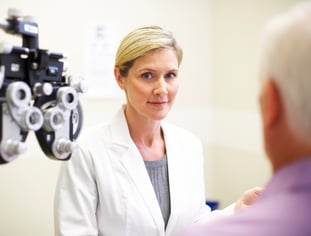Discovering the current Technological Developments in Optometry and What They Mean for Optometrists
From the accuracy of Optical Coherence Tomography to the nuanced insights used by AI-driven diagnostic devices, these advancements are establishing brand-new standards in individual analysis and treatment. As these improvements penetrate the practice, optometrists are faced with the difficulty of welcoming these devices to boost patient results.
Advancements in Diagnostic Equipment
Progressing the field of optometry, developments in diagnostic devices have actually reinvented the method eye care experts assess and diagnose aesthetic problems and ocular conditions. The previous years has actually seen substantial technological improvements, allowing even more accurate and comprehensive assessments.
One more secret advancement is the introduction of advanced corneal topography systems, which map the surface area curvature of the cornea with precision. These devices are specifically useful for suitable contact lenses and identifying corneal problems. Digital retinal imaging has actually transformed conventional ophthalmoscopy, using thorough, panoramic views of the retina that help with complete aesthetic exams.
The growth of wavefront aberrometry has actually additionally been crucial, enabling the analysis of refractive errors with unrivaled accuracy (Optometrist Chino). This technology helps in customizing restorative lenses and improving medical outcomes for refractive surgical procedures. Collectively, these diagnostic advancements empower optometrists to deliver superior patient care, ensuring very early treatment and customized treatment techniques, ultimately enhancing aesthetic health and wellness results
AI in Individual Management
Structure on the foundation of sophisticated diagnostic devices, the consolidation of artificial intelligence (AI) in individual management stands for a transformative jump for optometry. AI systems are significantly employed to improve efficiency, precision, and customization in client care.
Moreover, AI-driven platforms assist in structured person interactions and administrative procedures. Automated organizing, digital appointments, and customized follow-up strategies not just boost person satisfaction however additionally optimize time monitoring for practitioners. These systems can triage patients based upon the necessity of their conditions, guaranteeing that those in essential need receive prompt attention.
Moreover, AI boosts decision-making by giving eye doctors with evidence-based recommendations and therapy pathways. By integrating data from digital wellness documents, AI tools offer insights that educate scientific decisions, reducing the threat of mistakes and enhancing individual outcomes. As AI proceeds to advance, its function in patient monitoring will likely broaden, improving the landscape of optometric treatment.
Breakthroughs in Retinal Imaging
In the realm of optometry, retinal imaging has actually experienced amazing technical advancements that are improving analysis capabilities and client care. Developments such as Optical Comprehensibility Tomography (OCT) and fundus digital photography have changed exactly how optometrists evaluate the retina and envision. OCT, specifically, supplies high-resolution, cross-sectional pictures of the retina, permitting the in-depth examination of its layers. This capability is indispensable for early detection and management of problems like glaucoma, diabetic retinopathy, and age-related macular degeneration.
Enhanced imaging techniques like OCT angiography are additional refining analysis precision. Optometrist Chino. Such innovations assist in the identification of min retinal adjustments that could indicate illness progression.
In addition, innovations in expert system are augmenting retinal imaging by making it possible for automated analysis of large datasets. These systems assist eye doctors in recognizing patterns a sign of pathology, consequently boosting diagnostic precision and efficiency. Collectively, these developments are transforming retinal imaging into a cornerstone of modern-day eye treatment, boosting end results and expanding restorative opportunities.
Teleoptometry's Growing Role
Teleoptometry is significantly becoming a vital part of eye care, driven by developments in digital interaction click this link and diagnostic devices. This is particularly beneficial in rural and underserved locations where accessibility to specialized eye care is typically restricted.
The assimilation of man-made knowledge (AI) more boosts teleoptometry, enabling the evaluation of visual information and assisting in the discovery of eye conditions such as glaucoma and diabetic retinopathy. AI-powered algorithms can rapidly analyze complicated imaging information, providing eye doctors with beneficial understandings that strengthen scientific decision-making.
Moreover, teleoptometry supports continuity of treatment with seamless integration with electronic health documents (EHRs), permitting eye doctors to maintain detailed individual histories. When seeking advice from with different experts., this makes sure that individuals obtain personalized and regular treatment also.
In spite of these advantages, difficulties continue to be, consisting of making sure data safety and managing patient assumptions. Nevertheless, teleoptometry stands for a considerable stride towards more available, efficient, and patient-centered eye treatment. As technology advances, its role is positioned to broaden additionally.

Future Trends in Eye Care
A myriad of innovative fads is readied to improve the future of eye care, driven by technological advancements and the advancing needs of clients. One significant trend is the assimilation of man-made knowledge (AI) in diagnostics, which assures to enhance the precision and performance of eye evaluations. AI formulas can assess substantial quantities of information from retinal photos, possibly discovering conditions like diabetic person retinopathy and glaucoma earlier than conventional approaches.
Additionally, individualized medication is getting traction in optometry, with hereditary testing notifying personalized treatment plans. This method aims to optimize client end results click resources by customizing interventions to specific genetic accounts. Wearable technology, such as wise get in touch with lenses, is also coming up, offering real-time surveillance of intraocular pressure or sugar levels, thus providing continuous understandings into ocular and systemic health and wellness.
The adoption of augmented reality (AR) and online truth (VR) in training and individual education is one more emerging pattern. These modern technologies provide immersive experiences that can enhance understanding and abilities both for patients and optometrists. As these fads progress, eye doctors have to stay abreast of technical developments to offer sophisticated care, guaranteeing better patient end results and satisfaction in the dynamic landscape of eye treatment.
Final Thought

Jointly, these analysis improvements equip eye doctors to provide premium person care, guaranteeing very early intervention and tailored treatment strategies, ultimately enhancing aesthetic health results.

As these modern technologies continue to advance, optometrists should adjust and include them into method, eventually maximizing process efficiency and boosting the criterion of eye treatment delivered to clients.